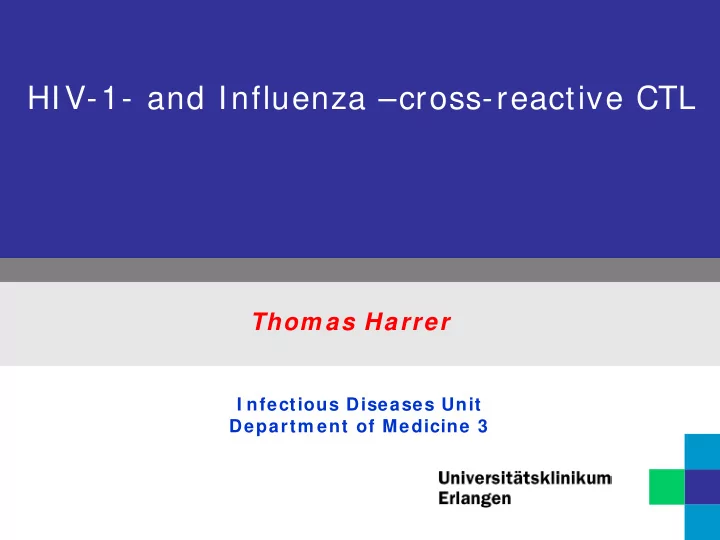

HIV-1- and Influenza –cross-reactive CTL Thom as Harrer I nfectious Diseases Unit Departm ent of Medicine 3
Detection of HIV-1-specific CTL in HIV-1-exposed Seronegative Subjects (Roland-Jones et al., 1998) CTL potential mechanisms: HLA TCR abortive infection immunization by infected cells without infection induction of cross-reactive CTL by other pathogens expressing epitopes with homology to HIV-1 epitopes
Cross-reactivity between the HIV-1-p17-epitope SLYNTVATL (SL9) and the influenza M1 matrix protein epitope GILGFVFTL (GL9) HIV-1 p17 SL9 Influenza IMP GL9 SLYNTVATL GILGFVFTL CTL CTL SL9 and GL9 have been published as immunodominant HLA-A2-restricted CTL epitopes in HIV-1-infection and in influenza, respectively Acierno et al. showed GL9-cross-reactive CTL in HIV-1-infected patients and SL9-cross-reactive CTL in influenza patients. Acierno PM et al. Cross-reactivity between HLA-A2-restricted FLU-M1: 58-66 and HIV p17 GAG: 77-85 epitopes in HIV- infected and uninfected individuals. J Transl Med. Aug 14 2003; 1(1): 3.
T-cell receptor cross-recognition: potential mechanism TCR-Peptide interaction: Same TCR-interface different TCR-interface CTL CTL CTL a ß a ß a ß V V F F F T A G V F N G S G T Y T I L L G T L L L L I
Do SL9/ GL9-cross-reactive CTL contribute to resistance to HIV-1 infection ? What is the prevalence in HIV-1 negative subjects ? What is the prevalence in HIV-1 exposed seronegatives ? influence the course of HIV-1 infection ? Hypothesis: pre-existing SL9/GL9 cross-reactive CTL could exert a rapid antiviral response and lower viral setpoints leading to a better course of infection
Generation of GL9- and SL9-specific CTL Stimulation of 5 Million PBMC each with SL9- and GL9-peptides Testing of outgrowing cells for recognition of SL9 and GL9 in γ -IFN ELISPOT assays
Recognition of SL9 and GL9 in HLA-A2+ HIV-1-negative patients Only 2/18 HIV-1-negative blood donors generated CTL against GL9 which did not cross-react to SL9. No SL9-CTL. Only 1/7 exposed seronegative patients generated both GL9- and SL9- specific CTL, however, without SL9/GL9-cross-reaction In addition, freshly isolated PBMC from another exposed seronegative patient showed GL9- and SL9-specific CTL responses, however, no proof of cross-reactivity as no CTL lines could be generated
Recognition of SL9 and GL9 in HLA-A2+ HIV-1-negative patients GL9-specific CTL were detected only in a minority of HLA-A2-positive healthy blood donors potential reasons good vaccination status prevents influenza infection and induction of CTL low precursor frequency of influenza – specific CTL in healthy subjects SL9-specific CTL in 2/ 8 exposed seronegatives, but no cross-reaction to GL9. This argues against a major role of GL9/ SL9-cross-reactive CTL in resistance against HIV-1 infection
Recognition of SL9 and GL9 in HLA-A2+ HIV-1-infected patients 175 HIV-1-infected subjects, among them 145 on ART Detection of: SL9-specific CTL in 92 patients (52.6% ) GL9-specific CTL in 94 patients (53.7% ) SL9- and GL9-specific CTL in 71 patients (40.6% ) CTL against SL9 and/ or GL9 in 115 patients (65.7% )
Cross-recognition of SL9- and GL9-specific CTL 60 of 92 SL9-specific CTL lines (65.2% ) recognized GL9. 62 of 94 GL9-specific CTL lines (66% ) recognized SL9. cross-reactions between GL9 and SL9 observed in 75 of 175 patients (42.9% ).
Cross-reactive TCR show equally efficient recognition of SL9 and GL9 peptides in peptide titration experiments in g-IFN-ELISPOT assays 26 SL9/ GL9-cross-reactive CTL lines (10 SL9- and 16 GL9-stimulated CTL lines) E F GL9-line + GILGFVFTL 400 300 GL9-line + SLYNTVATL 350 250 SL9-line + SLYNTVATL 300 SFU/50000 cells 200 SL9-line + GILGFVFTL 250 150 200 150 100 100 50 50 0 0 no + 20 + 10 + 1 + 100 + 10 + 1 + 0,1 + 20 + 10 + 1 + 100 + 10 + 1 + 0,1 no peptide peptide µg/ml µg/ml µg/ml ng/ml ng/ml ng/ml ng/ml µg/ml µg/ml µg/ml ng/ml ng/ml ng/ml ng/ml
CD4 counts and viral loads in patients without ART No significant differences regarding recognition of SL9/GL9 CR: cross-recognition
CD4 counts and viral loads in patients on ART * higher CD4 counts in patients with recognition of SL9. p = 0.007 ## lower viral loads in patients with reognition of SL9. p=0.026 Kein Unterschied bei Patienten mit und ohne Kreuzreaktion: CR+ vs CR-
Conclusions HLA-A2+ HIV-1-infected patients, but not HIV-1-negative subjects, frequently generate SL9/GL9-cross-reactive CTL This indicates, that cross-reactive CTL are primed by HIV-1 and not by influenza SL9-specific CTL are associated with higher CD4 counts and lower viral loads in patients on ART SL9/GL9-cross-reactive CTL do not influence the course of HIV-1-infection Further studies are needed to evaluate whether HLA-A2+ HIV-1-infected subjects with SL9/GL9-CTL have a lower risk for influenza infection or disease.
Hückelhoven et al., JAIDS 2015 Angela Hückelhoven Jennifer Etschel Sandra Müller-Schmucker Kathrin Zitzelsberger Silke Bergmann Ellen Harrer
Cross-recognition of 11 different SL9 variants by SL9- and GL9-specific CTL lines. Cross-reaction SL9-specific CTL GL9-specific CTL SL9+,GL9+ SL9+, GL9- GL9+, SL9+ GL9+,SL9- + SLYNTVATL 66 6 69 0 + GILGF-F-- 66 0 69 2 + --F------ 12 4 6 1 + --F-A---- 2 0 6 1 + --Y-A---- 2 0 4 2 + -------Y- 7 0 9 0 + ----A--V- 3 1 2 0 + ----A--A- 3 0 7 0 + -------V- 11 5 7 0 + --F--I--- 7 2 8 0 + --F----V- 10 5 5 0 + ------SA- 4 1 5 0 + ----A--S- 2 0 3 0
Cross-recognition to SL9 or GL9 in % of recognition of the peptide used for stimulation Magnitude of response in % 275 250 225 200 175 150 125 100 75 50 25 0 0 GL9 CTL SL9 CTL recognizing recognizing SL9 GL9
Recommend
More recommend